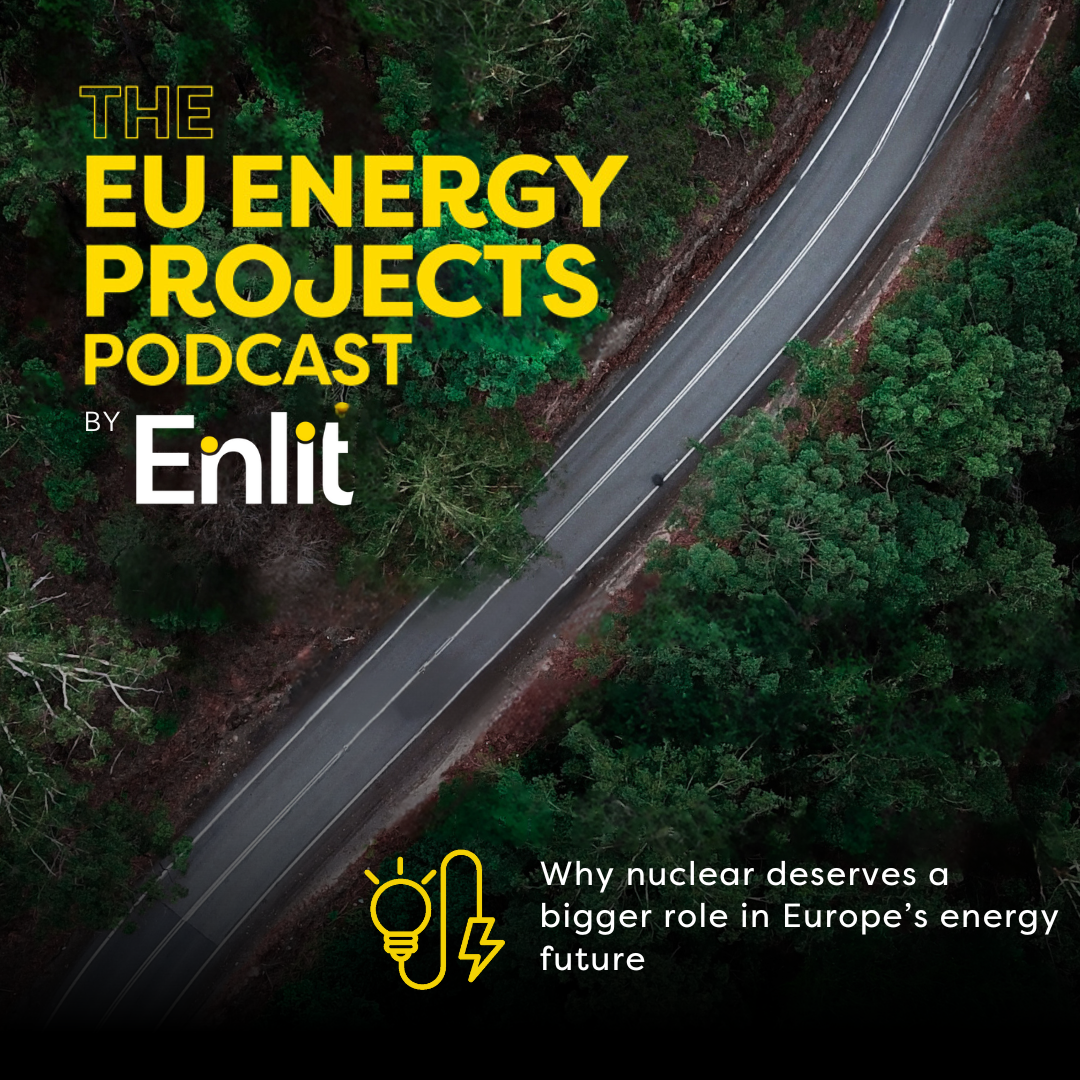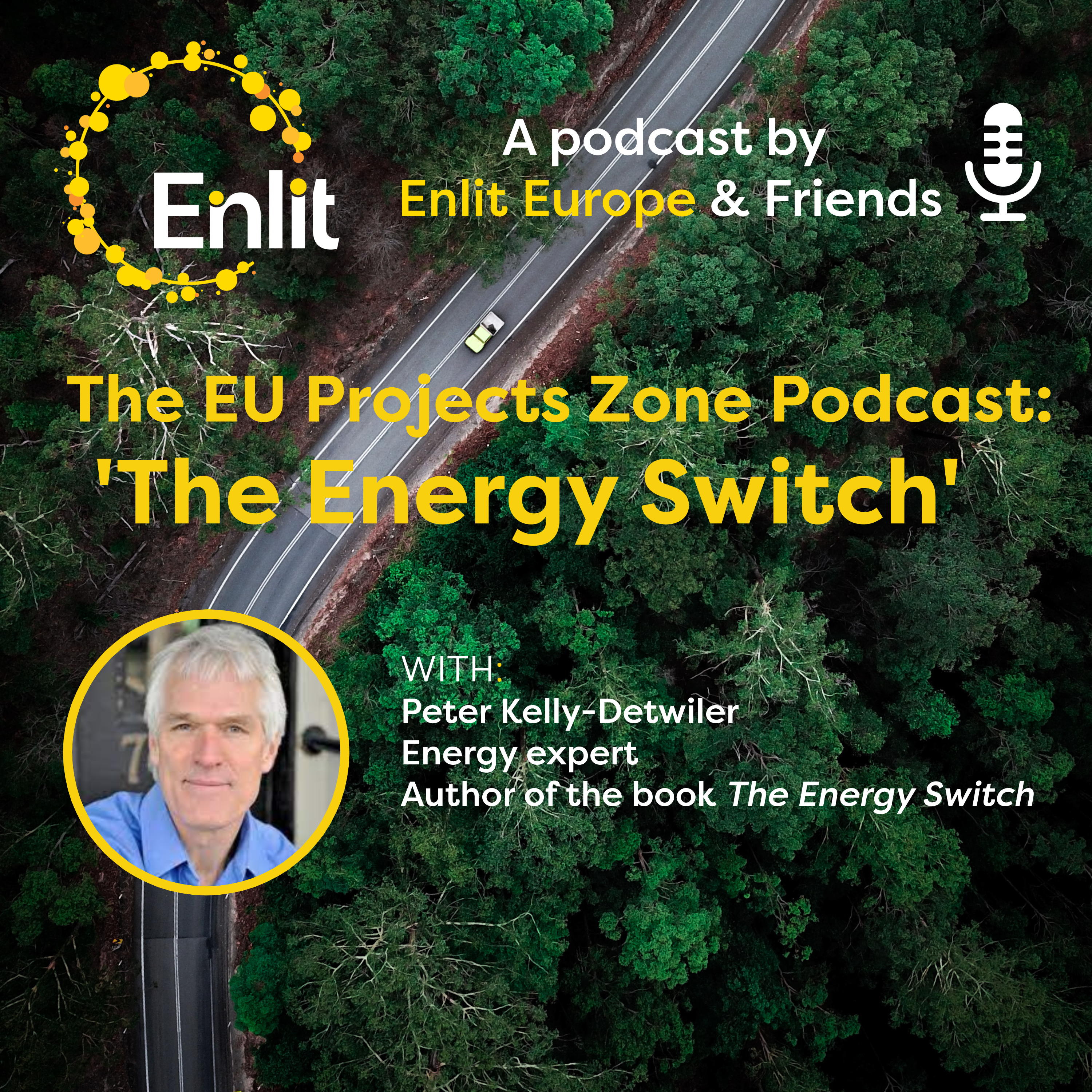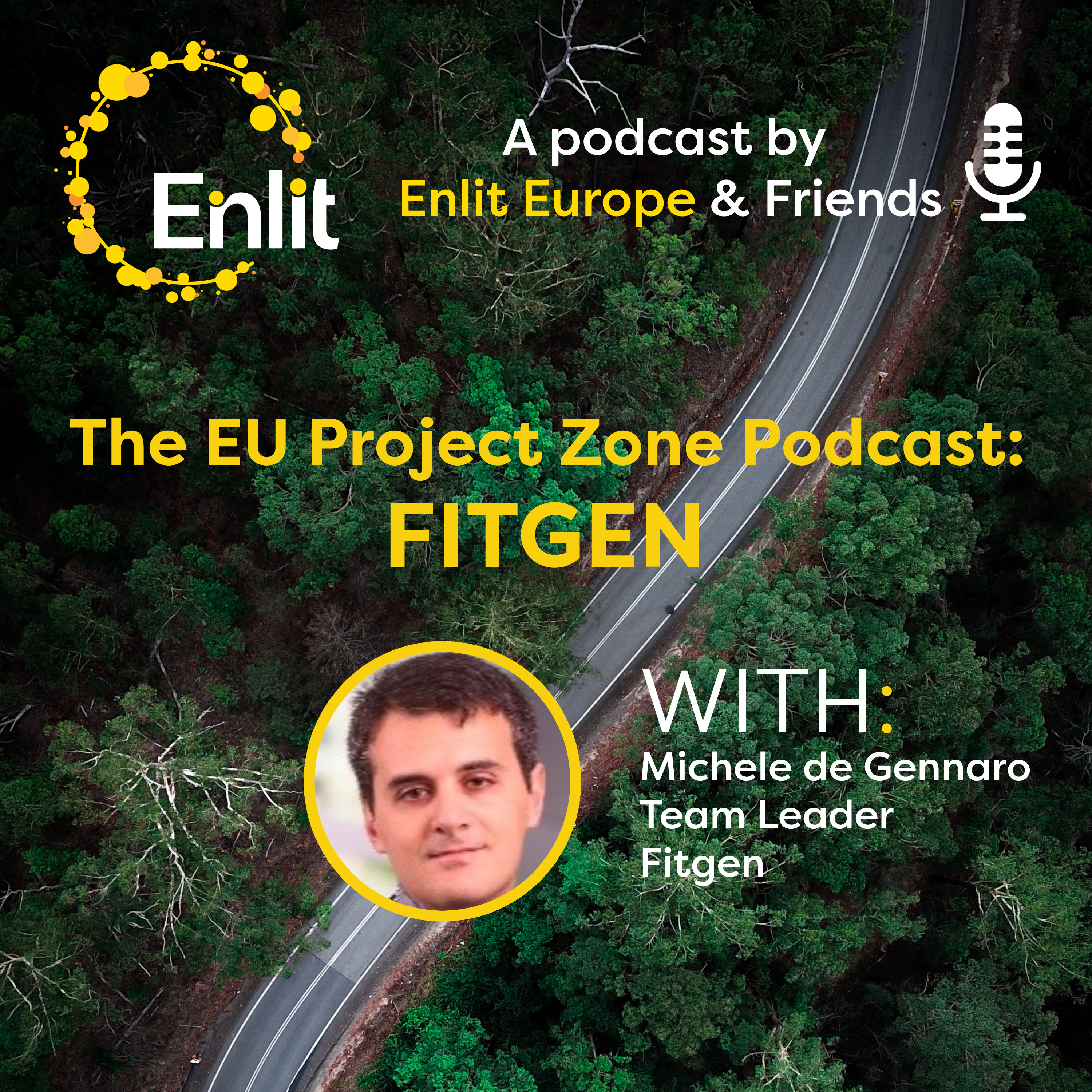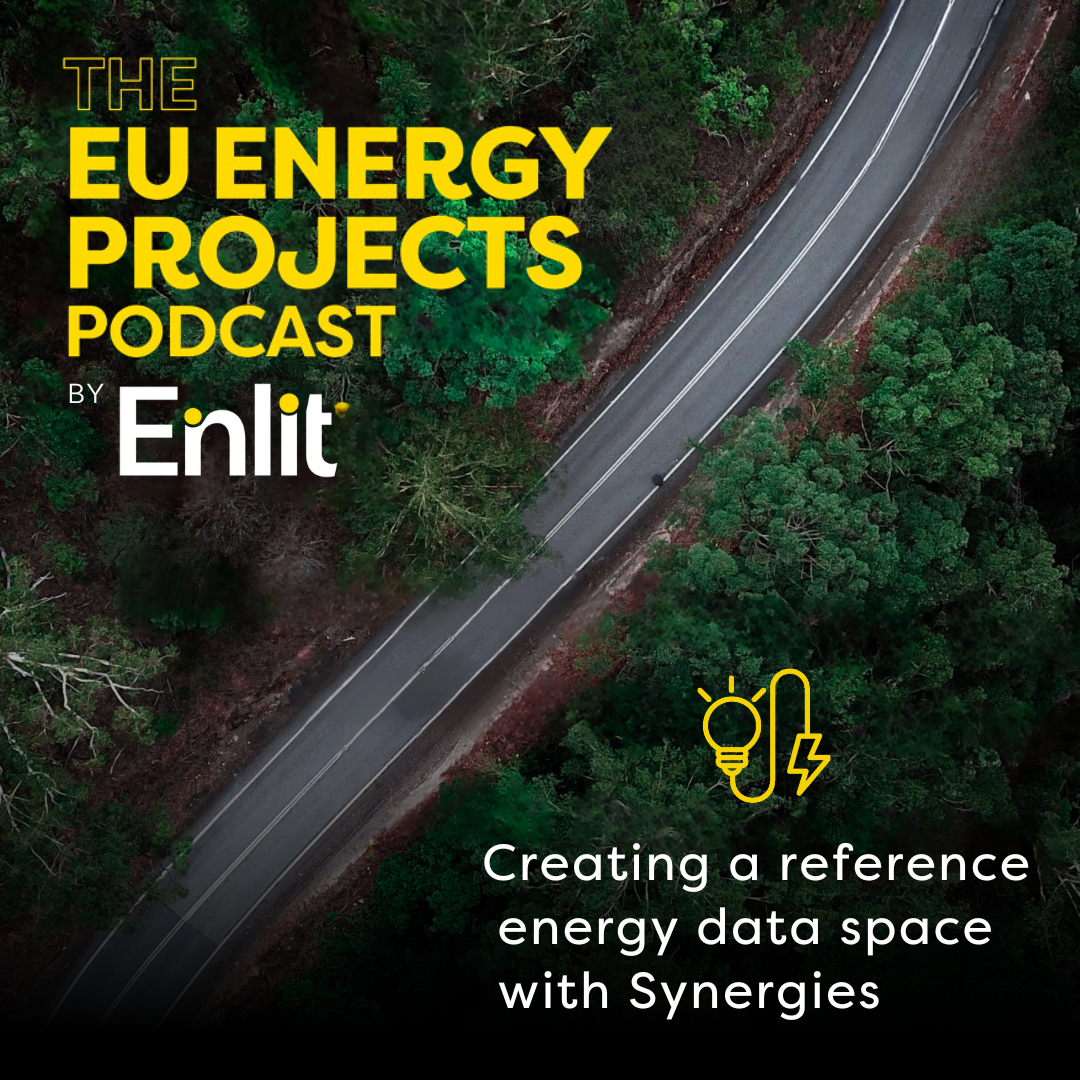Episode Transcript
[00:00:10] Speaker A: Welcome to the EU Energy Projects Podcast, a podcast series from Enlida and France focusing on the clean energy transition for the European Union and the EU Commission funded energy projects that will help us achieve it. My name is Aretid Daradimu. I. I am the editor of the EU Energy Projects Podcast and your host.
Hello everyone. In this episode of the EU Energy Projects Podcast we are going to explore the role of nuclear energy in Europe's transition to a low carbon future.
I am joined by Candice Budet, CEA and SNETP and Jan Prekhradni, Research Center Res and SNETP to discuss innovation, safety and collaboration in nuclear research as well as how projects are shaping energy systems beyond electricity generation. Thank you both for being here with me today. And Candice, I would like to start with you. Could you briefly introduce the CEA's role in supporting the energy transition and and carbon neutrality by 2050?
[00:01:22] Speaker B: Yes, sure. Thank you. Thank you RIT for inviting me to join your podcast.
So to answer that, I would say that CEA is driving France's energy transition, supporting industry, government and society on the road to net zero 2050 by cutting dependence on fossil fuel, boosting new energy industries and keeping costs down for citizens and businesses. The CEA combines ambition with responsibility, always meeting the highest safety and environmental standards. From nuclear to renewable storage to smart grids, the CEA looks at the entire low carbon energy systems. Its research blends advanced simulation, state of the art facilities and strong global partnership turning science into solutions for sustainable energy.
[00:02:11] Speaker A: Thank you Candice. Jan, could you also give us a short introduction of CBR and present its actions?
[00:02:17] Speaker C: Thank you very much.
So the Research center is a very important research institution in the Czech Republic, but I believe also within Europe and other OECD countries.
The main areas of our activities include research support of the operation of nuclear and conventional power plants, research and development in the field of advanced nuclear technologies such as Generation 4 reactors, SMRs and FUSIONS, research support of the treatment and storage of radioactive waste and research and development in the field of emission free energy and advanced energy technologies where special attention is currently paid to energy storage and thermodynamic circuits. A special role in our portfolio of activities is played by advanced material research which is a cross cutting and key topic for all research areas.
At the research centric we have a number of interconnected research infrastructures of technologies thanks to which we are now able to cover the complex needs of research and development in nuclear energy. For example, we are able irradiate the material under test in our research nuclear Reactor or expose it in a loop in the required environment, then perform wide range of mechanical tests in hot chambers and then analyze the effect of radiation and media or media on the microstructure of materials and state of the art electron microscope facility.
[00:04:10] Speaker A: Thank you Jan Candice, we have one more acronym to explain to those less familiar and that is snetp. So could you also briefly tell us what is SNETP and how does it connect nuclear research with Europe's broader energy goals?
[00:04:28] Speaker B: Yes, sure. Thank you for this question. So SNCP is a European technological platform for sustainable nuclear energy.
It's an international nonprofit association bringing together international community of over 115 members from industry to research university to innovators all working together to make nuclear energy safer, smarter and more sustainable.
Across its three pillars ASIN ATP is driving progress. The first is with advanced student reactors to be safer and more efficient in generation two and three of civil nuclear. Then you have ESNI developing generation four systems to unlock the full potential of nuclear while minimizing the waste.
And the Last1 is NC2I opening the door to nuclear cogeneration, delivering clean electricity, heat and even hydrogen for low carbon future.
SNETP is more than a platform. We can say it's a movement uniting science, industry and innovation to power the energy transition.
So if you let me, if you give me four more minutes on that to explain the link between R and D and sntp, we can say that SNETP plays a kind of bridge role between cutting edge nuclear research and the EU long term vision for a cleaner, more secure and more resilient energy system.
First, SNETP makes sure that nuclear invasion is part of part of the conversation in Brussels.
SNTP regularly works with the European Commission contributing to policy discussion, writing down position papers showing how nuclear technologies can help reach net zero targets, boost energy independence and support industrial competitiveness.
SNTP is also deeply involved in advancing small modular reactors and other innovative system like the European Industry alliance for smr. This could make nuclear energy more flexible, scalable and easier to integrate with renewable, which is the key to balancing Europe's future energy mix.
All of this means that nuclear research isn't happening in a silo. It's directly linked to Europe border goals, cutting emissions, securing energy supply, reinforcing industry and creating a low carbon future where nuclear plays a complementary role alongside renewable. And that's the target of snetp.
[00:07:15] Speaker A: Sounds great. And let me say here that those of our audience that would like to learn a little bit more on SNETP and the projects that it works on. They will have that opportunity at end. Lead Europe at the EU project zone where SNETP will take part with four or five projects and a very important and interesting, I think so, session on nuclear on the first day of the event.
But let us go a little bit further in the nuclear contribution in the energy transition. And Jan, why do you think that nuclear's contribution to the energy transition is sometimes underestimated compared to renewables, for example?
[00:07:56] Speaker C: Unfortunately, the underestimation of nuclear energy is one of the longest standing standing difficulties this sector has faced.
It's terrible, but it is true in my opinion, nuclear power plants are currently the best technical, organized solution for providing a long term reliable and high performance source of electricity that we are capable of designing and operating safely.
Nevertheless, several unfortunate incidents or accidents in the past have significantly damaged the reputation of nuclear energy. Whether we speak about the accident in female Island, Chernobyl or Fukushima, each of them had a strong impact on public perception.
Moreover, unfortunate actions taken by some politicians, mainly after Fukushima, have further harmed this reputation, leading to the widespread belief that nuclear energy is inherently bad.
Another drawback of nuclear energy is the, I would say extremely lengthy process of licensing and subsequent construction of nuclear power plant.
While solar, for example, solar plant can be built within days, a nuclear power plant often takes many years to complete. In today's world, where many politicians, managers or other decision makers are elected or appointed only for a limited time, the constructions of nuclear power plant is in a way politically unfeeling because the person who makes the decision to build will not be the same, the one who inaugurates it.
As a result, there is often a lack of political courage to commit to such long term projects.
Some hope, however, lies in the development and deployment of so called small modular actors.
[00:10:23] Speaker A: To be honest, Jan, as an energy journalist I understand why people might be afraid when accidents happen. What I never understood, however, is why, as you said, politicians and people that have the power to explain things, why don't they opt for more security instead of trying to obliterate a technology that could actually be the future or part of the future of the energy transition.
However, this is something that now, and correct me if I'm wrong, that now is changing and it is actually due to small modular reactors or SMRs. So Candice, how are we expected to. How are these reactors expected to change Europe's nuclear landscape both technically and politically, in your opinion?
[00:11:13] Speaker B: I agree with you, Areti and Jan. I mean technically the small modular reactor. They are smaller, they are modular, it's in the name and quicker to build than traditional reactors. That means lower upfront cost, faster deployment and more flexibility that could match with even the political mandate of some politicians.
And from powering the grid to producing hydrogen and industrial need, they are not only for electricity technically, they also bring advanced safety features and can fit more easily alongside renewables, helping balance Europe's energy mix politically, SMRs are a tool for energy independence and industrial leadership through the European Industrial alliance on smr, for example, governments, industry and researchers are working together to harmonize regulation, build supply chain and attract investment.
And in this industrial alliance I would like to recall that SNETP is really deeply involved at all stages since the beginning of this alliance and up to now. This cooperation makes nuclear more accessible for countries that might not commit to large plants, while also supporting Europe's climate and competitiveness goals.
In short, if I have to resume my views on the SMRs, they promise to make nuclear energy more flexible, affordable and politically achievable. This is a new chapter for Europe's clean energy transition as I see it.
[00:12:51] Speaker A: Hello everyone, Areti here. I would like to personally invite you to discover the EU Project Zone at Enlit Europe 2025 in Bilbao. Our event takes place from the 18th to the 20th of November. Come say hi to me at the EU Project Zone.
Jan, what role does R and D on hydrogen and solar integration play alongside nuclear in building a resilient low carbon system?
[00:13:24] Speaker C: Frankly speaking, solar and nuclear power plants have very little in common.
Their only real point of interaction is the unpredictable output of solar plants which must be backed up by an independent source.
However, nuclear power plants are generally not suitable for this purpose as their operating characteristics do not allow or rapid and large output fluctuations.
And that's where hydrogen technologies come into play in the future. Hydrogen could theoretically help balance these fluctuations that nuclear power plants would otherwise need to handle due to the high share of solar panels.
The concept being considered is so called hydrogen storage.
During times of electricity surplus, hydrogen could be produced by electrolysis or other processes and later burned when electricity spells.
At present, however, there are still a number of technical barriers that prevent large scale deployment of hydrogen storage.
The most significant issue is the economic feasibility of such system or such solution.
In other words, or in numbers.
Let's say the hydrogen production itself lost about 30 40% of energy already during electrolysis, followed by another 10 maybe 15% during compression and up to 40% in the case of liquefaction.
And that's all before even accounting for storage and distribution losses. The overall round trip efficiency of the electricity to hydrogen to electricity chain is therefore usually only around 25 30%.
Let's say that in parallel, other energy storage systems are also under development.
These systems are called thermal energy storage. They often use molten salts and can store thermal energy in the scale of several hundred megawatts, for example.
However, here too the economic balance remains challenging, so these systems are still being developed with the goal of improving their technological efficiency. I believe in the future some combination of these types of energy accumulation could be used, but it will be in future.
[00:16:38] Speaker A: Of course it will be in future, especially if storage has something to say, because we're nowhere near yet when it comes to technologies like this. How will however, digital tools help us can this how will AI for example, through projects like LLMS4EU? If I pronounce it correctly, a project that will be at the EU Project Jonathan Litt how are they modernizing nuclear.
[00:17:02] Speaker B: Operations Then this project, the LLMS4EU that's quite hard is a project building a large language model and multilingual data set for sectors like energy, but not only energy, telecom, public services and science.
For nuclear and energy industries. It helps improve safety, assess risk and share knowledge even across different languages.
By giving small and medium enterprises access to these AI tools, the project boosts efficiency, support decision making and keeps operations compliant with energy regulation.
This from renewable energy to research and public administration, these models make cross border collaboration and innovation faster and smarter. This project is a proof that digital and linguistic inclusivity can supercharge industrial progress and to me that's a key to the future for nuclear.
[00:18:02] Speaker A: Absolutely. Metis is another example of a very good project and also Jan, you mentioned Fukushima, so Metis has focused on seismic safety which is very very important. How do advances in nuclear safety research also improve resilience in in non nuclear infrastructures?
[00:18:22] Speaker C: Nuclear industry has obviously strong background in safety assessment and advanced numerical analysis approaches, especially nuclear industry.
The Eurozone project Metis completed in May 2025 focused on seismic risk assessment for nuclear facilities.
The researchers developed computational models and probabilistic analysis to simulate how earthquakes might impact nuclear installations.
These tools allow operators and policymakers to make informed decision about infrastructure safety.
Performance based design and structural resilience are shared concerns for both nuclear and non nuclear infrastructures.
The methodologies developed by Metis project are valuable for wide range of critical infrastructure beyond nuclear facilities.
By simulating the effects of seismic events, these tools help engineers and planners assess vulnerabilities and impalement target risk reduction measures for bridges, hospitals, dams, energy grids and many other critical infrastructure.
Applying such models Enables industries to prioritize investments, improve disaster preparedness and maintain operation continuity during natural hazards.
Insight Insights from nuclear focused seismic risks assessment can therefore form safety strategies across urban infrastructure, industrial complexes and large scale energy systems. Enhancing resilience across sectors, sharing knowledge and developing new approaches jointly with nuclear industry and academic partners.
Benefits across fertilization of different sectors Dealing with safety I want to go back.
[00:21:10] Speaker A: A little bit on SNETP and the projects that it represents. I think, correct me if I'm wrong Candice, that they have a spillover, they have spillover effects beyond nuclear.
So can you give us an example where nuclear R and D directly benefits other industries?
[00:21:28] Speaker B: Yes, you are right and in the SNLTP project portfolio we do have many project like that like that one. So I will just pick one. It's El Pasolero. The project is taking a high end challenge in nuclear facility which is aging polymers. So wait for it. You're going to see how it can help the other technology we are talking about. Caves, seals and pipes degrade over time and keeping them safe is critical. This project has created a handheld optoelectronic system that gives operators real time diagnostics helping them spot wear and plan maintenance before the problem arises. But it's not just for nuclear plants. Wind, nuclear, solar and other energy sectors can use it to reducing downtime, improving safety and boosting reliability.
El Pace Tolero proves that artificial intelligence driven monitoring isn't just smart, it's essential for safer, more efficient and sustainable energy futures. But we do have a lot of more projects and you can have a look in the SNTP website and even during ellit. I mean it's a real opportunity to meet with the people and ask them what they are doing for nuclear and for the other technology too.
[00:22:54] Speaker A: Thanks Candice. I want to stay a little bit on the topic and ask you how can collaboration across sectors accelerate both innovation and public acceptance of nuclear technologies? Because this is a very very important aspect acceptance of the public for nuclear technologies.
[00:23:12] Speaker B: I mean for me the collaboration across the sectors is key to accelerating both innovation but also public trust in nuclear technology. Because it's what we are talking about is trust, confidence after the incidents and the fear that people may have.
By bringing together industry, researcher and public stakeholder, we pull expertise and resources to create safer, more efficient and cutting edge solutions.
At the same time, engaging with society helps address concerns, improve transparency and show the real benefits of nuclear energy.
Cross sector collaboration doesn't just drive innovation, it builds confidence, supports informed decision and helps integrate nuclear safely alongside renewables for a sustainable energy future. This is the key to cross collaboration between nuclear, wind, solar. Even they can discuss with storage and grids. That's essential.
[00:24:14] Speaker A: Candice, I couldn't agree more. An informed decision is always, let's say the goal when it comes to our to our continent, to the European and to the European Union. And when I ask Jan, how well are EU policies? Because this is quite an important topic also such as the green deal or fit for 55 aligned with nuclear innovation priorities today?
[00:24:37] Speaker C: Absolutely, without any reservations.
You know, I am reactor physicist and therefore I am a huge fan of nuclear energy.
But still I am ready to change my mind if someone shows me a better and more usable technology than nuclear reactor. However, this has not happened in my today more than 20 years of practice.
What other fully technology solution do we have for generating carbon free energy here in Europe? Oh my God. I apologize for my freakness, but unfortunately I have a little fate in other sources.
We can convince ourselves that solar energy will save us and we will be happy. But that is not the case.
Just let's compare installed capacity to actual production.
The difference between installed capacity and actual production is expressed in practice through the capacity factor.
Installed capacity represents the sum of all panels capacities and is approximately 340 gigawatts for European Union, it's from data from 2024.
Annual production is actual energy delivered over the year.
And in 2024 the solar generation accounted for 10, 11% for European electricity, which correspondence to hundreds of terawatt hours.
The calculation show us that the capacity factor for solar panel is roughly 10%, meaning that on average panels produce only 10% of what they would if running at full power, 24 per seven.
It's terrible, really terrible. The low annual percentage for Europe, but is relatively expected. The European Union is geographically diverse. North, south and seasonality reduces the early average. We have relatively long winter nights.
The typical range could be, I don't know, German 10, 11%.
Spain 15, maybe 17, 18. Okay, it's better. But still, for nuclear power plants, the capacity factor is significantly higher than for solar or wind. Because reactors run steadily and almost continuously.
The global average in recent years is around 80, 85%. In the European Union, most reactors operate in the range 70, 90% depending on fuel cycle, outages and maintenance.
Moreover, nuclear plant plants, all of them have an undeniable advantage. They are controllable and produce electricity even in a bad weather. In addition, carbon dioxide emissions from nuclear plants are virtually zero.
All research and innovation currently happening in the nuclear sector are directly focused on increasing safety, reliability and long term sustainability of the nuclear cycle materials and technologies for the nuclear power plants. So I fully believe all of this is directly aligned with the mentioned European goals.
[00:28:52] Speaker A: Jan, I appreciate your frankness, to be honest, and I would like to push it a little bit more by mentioning licensing and regulatory harmonization which I know remain complex for SMRs. So could you honestly tell us how a project like EasySMR, if I pronounce it correctly, is helping to streamline this process across Europe? A process that is really really complex and with a lot of obstacles.
[00:29:18] Speaker C: Easysmr is a European founded project developing light water small modular reactors which are compact scalable nuclear system that use water as both coolant and neutron moderators.
So we expect these two reactors could offer enhanced flexibility and fast deployment compared to traditional large scale plants. We spoke about that. So the project implements innovative advanced simulations to stuff for experiments and uses advanced 3D printing technique to manufacture complex components with higher precision and efficiency.
It also establishes standardized guidelines which streamline licensing and regulatory approval across Europe.
By emphasizing modularity and flexibility, EasySSR ensures its innovations can inform not only nuclear energy but but also broader energy systems supporting adaptable solutions for renewables, micro grids and industrial infrastructures.
Easy SMR contributes to licensing and regulatory harmonization in Europe by adopting a pragmatic and deployment focused approach rather than duplicating existing high level initiatives.
The project works directly with real European light water SMR designs such as Nubart Smart LDR 50 Calorina or Rolls Royce SMR and considers potential deployment context in countries like Finland, France, United Kingdom and Belgium.
The goal is to analyze specific regulatory bottlenecks that could hinder future licensing process and to propose actionable recommendations while specific regulatory challenges are still being explored.
Some examples such expansive safety system or industrialized construction methods is illustrate the kind of issues that may arise.
The work is carried out in close coordination with national authorities and aligned with the European Industrial alliance on similar thank.
[00:32:03] Speaker A: You Jan Candice, we mentioned it already or hinted on the skepticism that nuclear energy often faces.
So I was wondering what steps is SNETP taking to improve citizen trust and awareness?
[00:32:19] Speaker B: You're right Reiti, that nuclear energy often faces skepticism. We already talked about that a little bit, but so snetp we focus on openness and dialogue. We bring citizens, young researchers, policymakers and industry together at our forums.
We do have one per year. It's open to all we webinars which are you can find dates and topics online.
So the discussion about nuclear aren't happening behind closed doors. We publish position papers and project updates, openly making research transparent and accessible.
We also invest in SNTP in education and youth engagement because building trust means bringing understanding across the generations through project like SNDP Forward, for example, or even ofer, we open research facilities and studies to wider participation, helping to demystify nuclear sciences. I recall that offer was at ELNIC last year if I remember correctly. So in short, SNP approach is about transparency, education and inclusion. Making sure people see nuclear not as a secretive technology, but as a shared part of Europe's clean energy futures. And being part of HELMET is one step further to improve citizen awareness on nuclear.
[00:33:44] Speaker A: Speaking of education that you mentioned, Candice Jan, how do you see education and training shaping the next generation of nuclear experts in Europe?
Because we do need to see to the future.
[00:34:01] Speaker C: Also, the ensuring a skilled workforce for the next generation of nuclear experts is one of the key challenges currently facing the sector as all other sectors in Europe.
Let's say it while nuclear energy still benefits from a sufficient pool of expense today, maintaining this in the long term is a priority.
To address this, most institutions in Europe actively collaborate with educational institutions at all levels, from secondary schools to universities and other specialized training centers. Some selected students are often offered scholarship provided with topics for bachelor's, master's and doctoral thesis, and involved in R and D project alongside faculty. Additionally, lectures and dedicated courses at universities are offered by our companies to engage and motivate students to pursue careers in nuclear science and technology.
International organizations such as SNTP further support this effort by facilitating knowledge sharing and collaborating across Europe and globally, ensuring that the best practices and innovations are disseminated widely.
[00:35:41] Speaker A: As we're approaching the end of our conversation, I have a couple of questions to finish on a positive point.
I would like to ask you, Candice, what breakthroughs in nuclear technology excite you the most in the next 10, 15 years? Like what will come?
[00:35:58] Speaker B: What will come? You know that 10 to 15 years might sound a long time, but it's nuclear. It's quite a. You know, it's very short clapping your hand, spam. It's 15 years, so it must be something already in the pipeline. And to me the the biggest shift will be from artificial intelligences. We already spoke about some project using it, but to me it's a real way to streamline operation, improve safety and help countries agree on harmonized standards. Because that's going to be tricky part and identify which technology best fit with each nation's specific needs. We also need to take this into account and to me it's exciting to think how the artificial intelligences could not only make nuclear smarters but it could help build global collaboration for a cleaner and more resilient energy future.
[00:36:57] Speaker A: I couldn't agree more Candice. Yeah, that makes total sense. AI of course.
Jan, your thoughts?
[00:37:05] Speaker C: So 10, 15 years, it's too short horizon in the energy sector for truly breakthrough changes.
I believe and I hope, oh my God. That within this period we will be able to launch serial production of at least one, maybe two types of modular reactors, initiate of construction of several large reactors in Europe and see the global nuclear industry recover from years of prolonged stagnation. As for nuclear fusion, I expect its practical contribution to cure a longer timeline more likely in the same 30, 40 years as it has been discussed since my school days.
[00:38:01] Speaker A: Exciting, exciting years ahead. I see 10 to 15, but maybe even more of course Candice, if you could leave listeners with one key takeaway about nuclear energy's role in Europe's future, what would it be?
[00:38:18] Speaker B: I would say that nuclear energy is essential to reaching the net zero by 2050. We simply can't get the there without nuclear. So many people fear the technology but that fear fades when we understand how it works and how safety is carefully managed. Knowledge builds trust. Trust is key to embracing nuclear as part of the clean, reliable energy futures. And my last word would be Woman, go for nuclear.
There is so many men, it's a kind of girl power but we need, we need women in nuclear. And if you have time and go to see what wing Global is doing, they're doing great work, work and I encourage you to have a look on their activities. They're working on engagement, citizen training, education and that's my last word. Woman go for nuclear.
[00:39:13] Speaker A: My God. That is our new motto. Candice.
[00:39:15] Speaker B: I love it.
[00:39:16] Speaker A: I love it.
[00:39:18] Speaker C: Your thoughts definitely agree with Candice. Please woman, come on.
But I want to say just one short conclusion, please Apple to all. Let us avoid short term decisions, focus on the long term and make the most of the natural resources we have at our disposal. Resources that we can use efficiently, safety, safely and controllable.
My keywords for better tomorrows are go green, go nuclear.
[00:39:53] Speaker A: Another amazing motto. I'm going to use both of them with your permission in the article that I'm going to write about this discussion. Thank you both very much. I think this was a very interesting conversation. We explained a lot of things and I'm hoping that we put a little stone and towards people understanding a little bit nuclear a little bit more. I know that I over the years and with the help of organizations like snetp I got to understand and fear Less Nuclear myself. Thank you both very much.
[00:40:28] Speaker B: Thank you. Thank you, Areti. Thank you.
[00:40:33] Speaker A: You've been listening to the EU Energy Projects Podcast, a podcast brought to you by Enlit and France. You can find us on Spotify, Apple and the Enlit World website.
Just hit subscribe and you can access our other episodes too. I'm Areditaradimu. Thank you for joining us.




